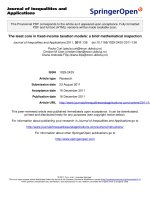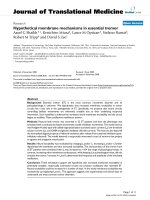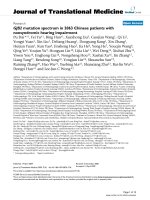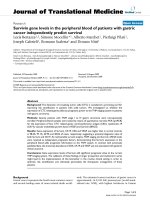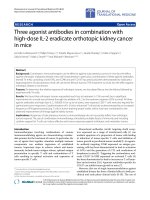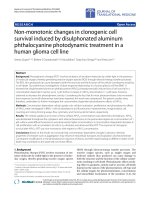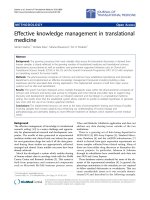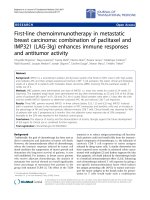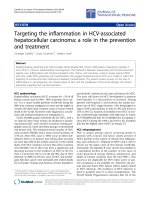báo cáo hóa học: " Air ambulance flights in northern Norway 20022008. Increased number of secondary fixed wing (FW) operations and more use of rotor wing (RW) transports" pot
Bạn đang xem bản rút gọn của tài liệu. Xem và tải ngay bản đầy đủ của tài liệu tại đây (498.23 KB, 9 trang )
ORIGINAL RESEARCH Open Access
Air ambulance flights in northern Norway 2002-
2008. Increased number of secondary fixed wing
(FW) operations and more use of rotor wing (RW)
transports
Jan Norum
1,2,3*
and Trond M Elsbak
4
Abstract
Background: Air ambulance service in Norway has been upgraded during the last years. European regulations
concerning pilots’ working time and new treatment guidelines/strategies have called for more resources.
Aims: The objective was to describe and analyse the two supplementary air ambulance [fixed wing (FW) and rotor
wing (RW)] alternatives’ activity during the study period (2002-2008). Furthermore we aimed to compare our
findings with reports from other north European regions.
Methods: A retrospective analysis. The air ambulance fleet’s activity according to the electronic patient record
database of “Luftambulansetjenesten ANS” (LABAS) was analysed. The subject was the fleet’s ope rations in northern
Norway, logistics, and patients handled. Type of flight, distances, frequency, and patients served were the main
outcome measures.
Results: A significant increase (45%) in the use of RW and a shift in FW operations (less primary and more
secondary) were revealed. The shift in FW operations reflected the centralisation of several health care service s [i.e.
percutaneous cardiac intervention (PCI), trauma, and cancer surgery] during the study period. Cardiovascular
disease (CVD) and injuries were the main diagnoses and constituted half of all operations. CVD was the most
common cause of FW operations and injuries of the RW ones. The number of air ambulance operations was 16
per 1,000 inhabitants. This was more frequent than in other north European regions.
Conclusions: The use of air ambulances and especially RW was significantly increased during the study period. The
change in secondary FW operations reflected centralisation of medical care. When health care services are
centralised, air ambulance services must be adjusted to the new settings.
Introduction
Northern Norway covers half of Norway’s land area and
constitutes in size about two-thirds of that of the UK.
Including the sea (Norwegian and Barents Sea) areas
under Norwegian surveillance, the figures are signifi-
cantly increased [1]. The people of northern Norway are
scattered and the total population is only about 460,000
inhabitants. One fourth of the population are citizens of
Bodø and Tromsø. About 2,500 people live in the
Norwegian Arctic (Svalbard, Bear Island, Jan Mayen,
and Hopen). The main industry in the region is fishery,
and many fishermen are on board vessels in the Norwe-
gian and Barents Sea. Oil and gas production is a grow-
ing business in northern Norway. The significant
distances between the populated areas have been a con-
stant challenge to the specialised health care service in
terms of costs and logistics. In 2010, the Northern Nor-
way Regional Health Authority (NNRHA) trust will
spend Norwegian krone (NKr) 337 million (Euros €43
million) on air ambulance operations. The amount
accounts for 3% of the total budget.
* Correspondence:
1
Department of Clinical Medicine, Faculty of Health Sciences, University of
Tromsø, N-9037 Tromsø, Norway
Full list of author information is available at the end of the article
Norum and Elsbak International Journal of Emergency Medicine 2011, 4:55
/>© 2011 Norum and Elsbakk; licensee Springer. This is an Open Access article distributed under the terms of the Creative Commons
Attribution License ( which permits unre stricted use, distribution, and reproduction in
any medium, provided the original work is properly cited.
Northern Norway has a subarctic and arctic climate
that introduces several challenges, especially during win-
ter time. Cold and rough weather conditions, long dis-
tances, seasonable darkness, and snow have to be
handled.
During the last de cade several factors have i ntroduced
an increased pressure on the air ambulance resources.
The European Union (EU) h as introduced new restric-
tions on pilots’ duty. Furthermore, new treatment meth-
ods and guidelines have been introduced. The
implementation of percutaneous coronary interventions
(PCI) in the treatment of cardiovascular disease at the
University Hospital of North Norway (UNN) trust in
Tromsø is such an example. The regional trauma centre
established at the same place is another one. Similarly
the care of severely injured patients has been mainly
centralised to the hospitals in Bodø and Tromsø, respec-
tively. A new guidelineforthecareofischemicstroke
has called for emergency radiological diagnostics fol-
lowed by immediate thrombolytic care. These changes
have caused an increased pressure on the air ambulance
resources. With this back ground, we aimed to analyse
and describe the changes taken place during the last
decade and compare our findings to those of other
north European regions.
Materials and methods
To meet people’s expectations, the NNRHA trust has 11
air ambulance resources [6 planes (Beechcraft King Air
2002/B200), 2 ambulance helicopters (AH) (Augusta
AW 139), and 3 search and rescue helicopters (SRH) (2
Sea Kings and 1 Super Puma)] scattered (7 locations)
within the region. Details are shown in Figure 1. The
SRHs are run by the Norwegian Air Force and the
others administered by Luftambulansetjenesten ANS
(). The fixed wing (FW)
resources are manned with a pilot, co-pilot, and regis-
tered nurse with basic education in anesthesia and/or
intensive care and special education in flight medicine.
The rotor wings (RW) are manned as foll ows: The AHs
are midsized helicopters with a crew consisting of a
pilot, rescuer, and anaesthesiologist. The SRHs are
manned with a crew of six members (pilot, co-pilot,
engineer, navigator, rescuer, and anaesthesiologist). The
ambulance helicopters are equipped with advanced med-
ical equipment permitting a high degree of emergency
and intensive care. The helicopters are mostly used out-
side urban areas because ground ambulances are often
quicker to the incident site in urban areas. In the north-
ern part of Norway, the flying distances may be so long
that refueling may be necessary for a helicopter. This
makes transport with aircraft, or “fixed wing”, an attrac-
tive alternative for inter-hospital transports. The advan-
tage is higher speed (2-2.5 times faster than a
helicopter), “all weather” capacity, and no refueling. The
disadvantage is the necessary secondary t ransport with
ground ambulances between h ospitals and airports.
Thus RW and FW resources are supplementary to each
other and not competing alternatives.
The main objective of this study was to describe and
analyse the two supplementary air ambulance [fixed
wing (FW) and rotor wing (RW)] a lternatives’ activity
during the study period (2002-2008). Furthermore we
aimed to compare our findings with reports from other
north European regions. The air ambulance fleet’s activ-
ity is prospectively registered in the electronic patient
record (EPR) system of the Luftambulansetjenesten ANS
(LABAS) () by the medical
crew (nurse or medical doctor). In February 2010, the
LABAS database was analysed retrospectively focusing
on the time period from 1 January 2002 until 31
December 2008. The data were collected by Trond M.
Elsbak in cooperation with the staff at the Luftambulan-
setjenesten ANS. The following data we re collected
using a specific report sheet.
- Flight data: Date and time of start and end of task,
time spent, state of emergency (non-urgent, urgent,
emergent) according to the Norwegian Index for Medi-
cal Emergency Assistance, and destination (hospital) [2].
- Patient data: Sex, age, nationality, diagnosis (acco rd-
ing to the international classification of d iseases, ICD),
oxygen support, intubation, analgesics given, state of
seri ousness [National Advisory Committee on Aeronau-
tics (N ACA) scale], intravenous adminis tration, and the
use of vasopressor drugs.
Boat and car ambulance ope rations were excluded
from the study. The latter has been dealt with in a prior
publication [3].
Our hypothesis was that the continu ous centralisati on
of advanced specialised health care (i.e. PCI, cancer sur-
gery, and trauma care) to the major hospitals has
increased the need for and use of air ambulance
resources. An equal impact on FW’sandRW’s activity
was anticipated. In this study, we also aimed to obtain
more knowledge of the service from an administrative
point of view and cr eate a foundation for future
research. Furthermore, we aimed to describe the service
performed in terms of patient and flight logistics
together with trends.
Statistical analysis and authorisation
The Microsoft Office Excel 2007 , Microsoft Corp., Red-
mond, WA, was employed for the calculations and data-
base. Statistical Package for Social Science (SPSS)
version 16.0, SP SS Inc., Chicago, IL, was employed for
statistical analyses. Cases with an unknown value for a
particular variable were excluded from analysis involving
that variable. Statistical analyses were performed
Norum and Elsbak International Journal of Emergency Medicine 2011, 4:55
/>Page 2 of 9
employing descriptive statistics and one-way analysis of
variance (ANOVA).
We accessed anonymous annual data from each air
ambulance location. We had no access to individual
patient identifiable data. Approval from the Regional
Committees for Medical an d Health Research E thics
(REK) was therefore not requested.
When mentioned, cost was reported in Norwegian
krone (NKr) and converted into Euros (€)atarateof1
€ = 7.8350 NKr as of the 11 June 2010 (http://www.
norges-bank.no).
Results
The inhabitants of northern Norway had a high con-
sumption of FW and RW resources (16 operations/
1,000 inhabitants/year) and the consumption incr eased
(from 15 to 18 operations/1,000 inhabitants/years) dur-
ing the study period. Whereas the number of RW
operations increased significantly (45% AHs, 54% SRHs),
there was a minor (9%) change in the use o f FWs. The
annual figures are shown in Table 1. The total figures in
2008 reached 7,745 operations [airplane 6,007, ambu-
lance helicopter (AH) 1,243, search and rescue helicop-
ter (SR H) 495]. The corresponding total flight time was
8,045 h. Thus the air ambulances are airborne on
average 1 h 2 min per task. The air ambulance opera-
tions performed by the two Sea Kings (SRHs) accounted
for one third of the total RW activity, and the busiest
months were July and August. The number of FW
operations with two patients on board rose by 14% and
reached38%attheendofthestudyperiod.The
Figure 1 The figure shows the locations of the air ambulance services in northern Norway. Figure from reference [14]. Stars = search and
rescue helicopter. Filled circles = airplane ambulance. Open circles = helicopter ambulance.
Table 1 The table shows the annual number of fixed
wing (FW) and rotor wing (RW) missions during the
study period (2002-2008)
Year
Air ambulance 2002 2003 2004 2005 2006 2007 2008
Rotor wing (RW) total 1,419 1,498 1,654 1,797 1,845 1,904 2,129
Brønnøysund* 396 423 433 551 543 473 470
Tromsø* 460 510 626 669 671 670 773
Banak & Bodø** 563 565 595 577 631 761 886
Fixed wing (FW) total 5,535 5,773 5,916 5,959 5,784 5,829 6,007
Kirkenes 993 1,018 962 991 1,004 1,020 1,002
Alta (2 FWs) 1,585 1,460 1,570 1,717 1,649 1,752 1,770
Tromsø 863 1,080 1,210 1,189 1,092 1,078 1,123
Bodø 1,128 1,236 1,293 1,298 1,252 1,243 1,259
Brønnøysund 966 979 881 764 787 736 853
Total (RW and FW)
*Ambulance helicopter (AH), **search and rescue helicopter (SRH).
Norum and Elsbak International Journal of Emergency Medicine 2011, 4:55
/>Page 3 of 9
increased number of inter-hospital transports (secondary
operations) improved the coordination of transfers.
Despite a significant number of transports, no acci-
dent occurred, and none of the crew memb ers were lost
during the study period.
The RWs transported patients were s omewhat
younger (mean age SRHs 48 years, AHs 47 years) than
those handled by FWs (mean age 55 years), but the dif-
ference was not statistically significant.
Whereas the delay in RW (AH) operations varied
between locations (68-84%), the RW-SRH crew did not
report data. This was probably due to Norwegian Air
Force regulations. However, the technical regularity was
99%. Concerning FW operations, the share of each
urgency (emergent, urgent and not urgent) group was
stable during the study period.
The most common diagnoses were coronary heart dis-
ease, injuries, cancer, delivery, respiratory disease, and
gastrointestinal disease. An overview of the diagnoses
with regard to RW or FW missions and number of
transports are shown in Figure 2. Whereas coronary
heart disease was the m ost common diagnosis in FW
operations, injuries was the most frequent one in the
RW setting. Cardiovascula r disease (CVD) and i njuries
were the main culprits causing raised activity and con-
stituted together half of all patients. During the study
period, the number of missions due t o CVD, injuries,
respiratory disease, and cancer rose by 19%, 23%, 21%,
and 15%, respectively. The number of transports related
to delivery and gastrointestinal disease were reduced by
17% and 13%, respectively. The trends are shown in Fig-
ure 3.
Whereas most of the RW operations are urgent or
emergent (92-95% of cases), FW activities are usually
(61%) n on-urgent. Details are shown in Table 2. This is
because FW operations often are planned inter-hospital
transports. Even inter-hospital transports of patients suf-
fering from acute myocardial infarction (MI) may be
non-urgent. Patients suffering from ST-elevated myocar-
dial infarction (STEMI) are frequently hospitalised at
the local hospi tal and treated with thrombolytic therapy.
When ECG changes normalise due to therapy, patients
may be transported to the university hospital for PCI in
a non-urgent setting.
A shift in air ambulance transport was revealed during
the study period. Whereas 34% of all FW operations
were “primary operations” (patients transported from
place of living to hospital) in 2002, the figure was 24%
0
2000
4000
6000
8000
10000
12000
14000
16000
Missions
Diseases
FW
RW
Figure 2 The figu re shows the number of operations with rega rd to diag nosis. This is according to rotor wing (RW) or fixed wing (FW)
transportation.
Norum and Elsbak International Journal of Emergency Medicine 2011, 4:55
/>Page 4 of 9
in 2008. The “secondary operations” (inter hospital
transports) increased from 36% to 46%. The shift is illu-
strated in Figure 4.
Looking at the National Advisory Committee on
Aeronautics (NACA) score, there were minor differ-
ences between the three types of operations. The mean
scores (0-7 scale) were: 3.2, primary operations; 3.6, sec-
ondary operations; 3.0, returns; respectively.
Looking for strategies to improve cost-effectiveness,
we revealed available r esources during night and week-
ends. Whereas the FWs are manned day and night all
week, the activity varie d significantly during 24 h. Night
flights are generally associated with increased risk, espe-
cially during winter time with seasonable da rkness.
However, during summer time the midnight sun offers
“daylight facilities”. Whereas the numbers of primary
transports were stable through the wee k, there was a
significant drop in secondary operations and returns
during weekends. Details are illustrated in Figure 5a
and 5b. Furthermore, we identified an underutilised
location in the southern region locat ed FW in
Brønnø ysund in which approximately half of the flights
left or returned to Brønnøysund without any patients
onboard. A simulation model (unpublished analysis
from the Luftambul ansetjenesten ANS, Bodø) indicated,
due to better patient logist ics, a saving of 11 million
0
500
1000
1500
2000
2500
3000
2002 2003 2004 2005 2006 2007 2008
Missions
Years
Cardiovascular disease
Injury
Tumors
Delivery
Respiratory disease
Gastrointestinal
Figure 3 The figure visualizes the number of flights [rotor wing (RW) and fixed wing (FW)]. Data were taken during the study period
(2002-2008) associated with the six most common diagnoses. RW = Rotor wing (helicopter). FW = Flight wing (airplane)
Table 2 The table shows the various stages of emergency
according to operations performed by the fixed wings
(FW) and rotor wings (RW), respectively
Variable FW RW (AHs) RW (SRHs)
Emergency status Non-urgent 61% 5% 8%
Urgent 21% 45% 35%
Emergent 18% 50% 57%
FW = Fixed wing = airplane. RW = Rotor wing [rescue and search helicopters
(SRHs) and ambulance helicopters (AHs)].
Norum and Elsbak International Journal of Emergency Medicine 2011, 4:55
/>Page 5 of 9
NKr (€1.4 million) by simply moving this plane to the
base in Bodø.
Discussion
Significant resources were employed in the air ambu-
lance services in our region. According to the literature
the gains related to RW operations have been inconsis-
tent. The first major comparison of outcome in the air
transport of trauma patie nts was publ ished by Baxt and
Moody in 1983 [4]. The study was a retrospective
TRISS-based analysis with a cohort of patients trans-
ported by ground as a control group. The authors
showed a 52% reduction in mortality with aeromedical
treatment (AMT). Mitchell and coworkers at the Dal-
housie University in Halifax, N ova Scotia evaluated the
transport of trauma patients with an injury severity
score (ISS) ≥12 by a dedicated RW air medical service
or a standard g round ambulance [5]. They concluded
that RW was associated with significantly better out-
comes than the control group. Ringburg and colleagues
[6] reviewed the literature and concluded helicopter
emergency medical services (HEMS) saved 2.7 additional
lives per 100 HEMS deployments. The positive effect of
HEMS has also been confirmed by McVey et a l. com-
paring air versus ground transport of major trauma
patients [7]. Snooks and coworkers analysed t he Heli-
copter Emergency Ambulance Services (HEAS) in Corn-
wall, London, and Sussex in the UK [8]. They compared
helicopter-attended patients and ambulance patients.
There were no improvements in response times and the
time on scene was longer for helicopter attended
patients. They concluded that survival of patients was
not improved by HEAS, and it was costly and the health
care benefits were minor. This may be due to shorter
transport distances and high-quality roads making a fast
intervention by ambulance possible.
Generall y, distances in excess of 30 min land travel to
definitive care are considered to support the u se of air
transport in preference of land ambulance [9-11].
According t o this statement, t he distances between
municipalities in northern Norway indicate helicopter
and airplane the preferable tool in many cases when the
patient is severely critically ill or injured. On the other
hand the more frequent use of RW should be further
examined as we have no general indications (i.e. num-
ber of road accidents) of an increase in the number of
injuries during the study period. In this setting the
planned register of trauma patients will be beneficial.
Looking at CVD, the recent improvements in outcome
with regard to PCI in acute myocardial infarction may
have influenc ed the increa sed use of RW. Looking at
place of living, there has been a growing centralisation
of the population during the last decades. This fact
could in the future reduce the need for air ambulances
as hospitals are located in the populated areas (main
cities).
Helicopters h ave limitations. Rough weather co ndition
with a risk of ice is a significant problem during winter-
time. Haug and coworkers looked at the access of HEMS
in the non-coastal areas of southern Helgeland (southern
0
500
1000
1500
2000
2500
3000
2002 2003 2004 2005 2006 2007 2008
Missions
Year
Primary
Secundary
Return
Figure 4 The figure illustrate s the trend in fixed wing activities. This was according to primary, secondary and return missions during the
study period (2002-2008). Primary operations = transporting patients from patient’s place of living to hospital; secondary operations = inter-
hospital transports; return = transport of patient back home.
Norum and Elsbak International Journal of Emergency Medicine 2011, 4:55
/>Page 6 of 9
areas of northern Norway) and revealed an availability rate
of only 40% in the time period between November and
March [12]. This is in accordance with our findings of the
lowest regulari ty (68% ) in t his reg ion. Nielsen concluded
based on this knowledge that the ambulance should always
be kept in mind as a good alternative [13]. However, in the
Norwegian Arctic, ambulances are no alternative as roads
are almost nonexistent [14].
a
b
0
100
200
300
400
500
600
700
800
900
Mon Tue Wed Thu Fri Sat Sun
Missions
Day
Primary
Secundary
Return
0
100
200
300
400
500
600
0 2 4 6 8 1012141618202224
MIssions
Hour (0-24 h)
Return
Secundary
Figure 5 The figure illustrates the fixed wing (airplane) activity during the week (a) and during 24 h (b). Most activities took place
during the daytime, Monday to Friday.
Norum and Elsbak International Journal of Emergency Medicine 2011, 4:55
/>Page 7 of 9
Quality of care is an important issue. Unfortunately,
we have no database at the NNRHA that could elucidate
this topic. A study by Caldow and colleagues reported
the exper ience from the Scottish Airambulance Serv ices
for 2002 and 2003 employing a helicopter for transfers
and primary scene responses in rural and island areas of
Scotland [15]. They recommend the establishing of a
formalised system to access suitably trained medical
staff instead of an ad hoc situation. Furthermore, they
stated that rapid sequence intubation skills were
required for any medical staff undertaking retrieval
work. This is in accordance with the manning of the air
ambulances in northern Norway. Hopefully, future Nor-
wegian quality of care registers (i.e. the national trauma
register) may document improved quality of care.
Benchmarking between health care providers may be
a way forward to achieve improved cost-effectiveness
and quality of care. Krüger and colleagues [11] ana-
lysed the Scandinavian pre-hospital physician-manned
Emergency Medical Services (EMS) and revealed that
differences were mainly related to time variables,
patient volume, and service area. The Danish and
Swedish services had higher volumes of patient care
encounters while the Finnish and Norwegian ones pro-
vided a wider v ariety of medical s ervices. Looking at
the number of missions performed by ambulance heli-
copters in our study (396 - 773 mission), this is in
accordance with Swedish figures varying between 400
and 1,200 per helicopter [16]. The helicopter in the
city of Gothenburg did about 1,000 missions a year,
with a total annual time in the a ir of 660 h. The corre-
sponding maximum total time airborne of the Tromsø
located AH was 689 h.
Patient transport by air is of great importance in Ice-
land because of its many sparsely populated areas and
long distances [17]. There are approximately 450 fixed-
wing ambulance missions annually. They have one dedi-
cated air ambulance airplane located at Akureyri. In
addition there are planes stationed in Westma n Islands
andÍsafjörður.Theseplanesaremannedonanadhoc
basis. Furthermore the coast guard runs three rescue
helicopters (Aerospatiale Dauphin a nd Aerospatiale
Super Puma). Thus six air ambulance resources serve a
population of 300,000 inhabitants. This is somewhat less
than o ur 11 units serving a population of 460,000 inha-
bitants in our region, but the geographical area of
northern Norway is gre ater than Iceland. In comparison
Scotland has a population of 5 million. There are two
helicopters (Eurocopter 1 35)andtwofixed-wingpres-
surized aircraft (King Air) for the sole use of the Scot-
tish Ambulance Service, which, when required, may be
backed up with Ministry of Defense and Her Majesty’s
(HM) Coastguard helicopters and other shared aircraft
[17].
Looking to Sweden, the four northern counties (Väs-
ternorrland, Jämtland, Västerbotten, and Norrbotten) of
Sweden share two fixed-wing air ambulances, which are
Beech King-Air 200 models [16,17]. The basic crew for
each plane is similar to those in Norway. These aircrafts
fly between 6,000-8,000 missions per year and the
majority is planned secondary transports between hospi-
tals. The population of the four northern Swedish coun-
ties in 2008 was in total 877,758 inhabitants and the
figure can thus be calculated 8 missions/1,000 inhabi-
tants. The Swedish figure is lower than ours and prob-
ably due to shorter distances, fewer people living in
remote areas, better weather conditions, and excellent
roads favouring ambulance cars. Furthermore, Norrbot-
ten county has an ambulance helicopter based in Gälli-
vare. This helicopter was employed in 375 missions (595
hours) in 2009. Of these operations, 57% were secondary
transports. These figures are comparable to our RW
ones.
Health care administrators should recommend bench-
marking analysis to achieve maximum return of invest-
ments. In view of the increasing use of air transport, it
is timely t o consider means by which cost-efficiency can
be improved. Activity data, as obtained and analysed in
our study, can be implemented in future cost-effective-
ness analysis. As an example a change of base of an air-
craft may introduce significant savi ngs and improved
availability. The implementation of medical emergency
motorcycle (MEM) assistance was analysed by Nakstand
and colleagues [18]. They concluded a small but signifi-
cantreductionindrivingtimewhenusinganMEM
instead of a car ambulance. Whereas the gain was of lit-
tle clinical importance, MEM was cheaper to operate,
but the cost-effectiveness was reduced as it could not
operate 12 months a year and was driven in daylight
only.
In conclusion, we have revealed an increased request
forairtransport(RWandFWoperation).Thetrendof
centralisation of specialised health care is likely to con-
tinue and consequently increase the need for air ambu-
lance resources. A significant increase in the use of RW
resources in our study should undergo further analysis
with regard to costs and strategic considerations with
regard to geographic location of air bases before further
economic resources are allocated to this service. Finally,
our data did not address the impact of additional flights
on primary outcome. In the future, improved patient
outcome could be an area of research, especially when
the trauma register has been implemented.
Acknowledgements
The authors wish to thank the personnel at the library of the University of
Tromsø for their support.
Funding
Norum and Elsbak International Journal of Emergency Medicine 2011, 4:55
/>Page 8 of 9
The study was funded by the Northern Norway Regional Health Authority.
Author details
1
Department of Clinical Medicine, Faculty of Health Sciences, University of
Tromsø, N-9037 Tromsø, Norway
2
Department of Oncology, University
Hospital of North Norway, N-9038 Tromsø, Norway
3
Northern Norway
Regional Health Authority trust, N-8038 Bodø, Norway
4
Helgeland Hospital
Trust, Sandnessjøen, P.O.B. 613, 8801 Sandnessjøen, Norway
Authors’ contributions
Both TME and JN took part in the design of the study. TME collected the
data from the LABAS database and presented an overview of the material.
JN carried out the statistical analysis, searched the PubMed database for
relevant studies/reports, and wrote the article. All authors read and
approved the final manuscript.
Authors’ information
The author is a medical oncologist, professor at the Faculty of Medicine at
the University of Tromsø, and medical director at the Northern Norway
Regional Health Authority.
Competing interests
The authors declare that they have no competing interests.
Received: 16 August 2011 Accepted: 30 August 2011
Published: 30 August 2011
References
1. Norum J, Endresen E: Injuries and diseases among commercial fishermen
in the Northeast Atlantic and Barents Sea. Data from Royal Norwegian
coast Guard. Int Arch Occup Environ Health 2003, 76(3):241-5.
2. Norwegian Medical Association: Norwegian Index for Medical Emergency
Assistance. The Laerdal Foundation for Acute Medicine, Stavanger, Norway;,
2.1 2005.
3. Norum J, Elsbak TM: The ambulance services in northern Norway 2004-
2008. Improved competence, more tasks, better logistics and increased
costs. Int J Emerg Med 2010, 3:69-74.
4. Baxt WG, Moody P: The impact of rotorcraft aeromedical emergency care
service on trauma mortality. JAMA 1983, 249:3047-51.
5. Mitchell AD, Tallon JM, Sealy B: Air versus ground transport of major
trauma patients to a tertiary trauma centre: a provincewide comparison
using TRISS analysis. Can J Surg 2007, 50:129-133.
6. Ringburg AN, Thomas SH, Steyerberg EW, Van Lieshout EM, Patka P,
Schipper IB: Lives saved by helicopter emergency medical services. An
overview of literature. Air Med J 2009, 28(6):298-302.
7. McVey J, Petrie DA, Tallon JM: Air versus ground transport of the major
trauma patient: A natural experiment. Prehosp Emerg Care 2010, 14:45-50.
8. Snooks HA, Nicholl JP, Brazier JE, Lees-Mlanga S: The costs and benefits of
helicopter emergency ambulance services in England and Wales. J Publ
Health Med 1996, 18:67-77.
9. Wills VL, Eno L, Walker C: Use of an ambulance-based helicopter retrieval
service. Aust N Z J Surg 2000, 70:506-510.
10. Cameron PA: Helicopter transport: can physicians save lives? Aust N Z J
Surg 1999, 69:690-691.
11. Krüger AJ, Skogvoll E, Castrèn M, Kurola J, Lossius HM: Scandinavian pre-
hospital physician-manned Emergency Medical Services–same concept
across borders? Resuscitation 2010, 81(4):427-33.
12. Haug B, Avall A, Monsen SA: Reliability of air ambulances. A survey in
three municipalities in Helgeland. J Nor Med Assoc 2009,
129(11):1089-1093.
13. Nielsen EW: Keep the feet on the ground. J Nor Med Assoc 2009,
129(11):1088
14. Norum J, Elsbak TM: Airambulance services in the Arctic 1999-2009. A
Norwegian study. Int J Emerg Med 2011, 4:1.
15. Caldow SJ, Parke TRJ, Graham CA, Munro PT: Aeromedical retrieval to a
university hospital emergency department in Scotland. Emerg Med J
2005, 22:53-55.
16. Björnstig U: Prehospital emergency care in Sweden - with special
emphasis on care of traffic victims. IATSS Res 2004, 28:24-31.
17. Gunnarsson B, Svavarsdóttir H, Dúason S, Sim A, Munro A, McInnesc C,
MacDonald R, Ängquist KA: Policy and service delivery. Ambulance
Transport and Services in the Rural Areas of Iceland, Scotland and
Sweden. J Emerg Primary Health Care 2007, 5:1-12.
18. Nakstad AR, Bjelland B, Sandberg M: Medical emergency motorcycle - is it
useful in a Scandinavian Emergency Medical Service? Scand J Trauma Res
Emerg Med 2009, 17:9.
doi:10.1186/1865-1380-4-55
Cite this article as: Norum and Elsbak: Air ambulance flights in northern
Norway 2002-2008. Increased number of secondary fixed wing (FW)
operations and more use of rotor wing (RW) transports. International
Journal of Emergency Medicine 2011 4:55.
Submit your manuscript to a
journal and benefi t from:
7 Convenient online submission
7 Rigorous peer review
7 Immediate publication on acceptance
7 Open access: articles freely available online
7 High visibility within the fi eld
7 Retaining the copyright to your article
Submit your next manuscript at 7 springeropen.com
Norum and Elsbak International Journal of Emergency Medicine 2011, 4:55
/>Page 9 of 9
